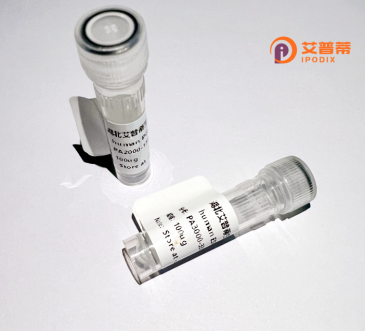
| 纯度 | >90%SDS-PAGE. |
| 种属 | Human |
| 靶点 | TCFL1 |
| Uniprot No | Q15906 |
| 内毒素 | < 0.01EU/μg |
| 表达宿主 | E.coli |
| 表达区间 | 1-364 aa |
| 活性数据 | MSLAGGRAPR KTAGNRLSGL LEAEEEDEFY QTTYGGFTEE SGDDEYQGDQ SDTEDEVDSD FDIDEGDEPS SDGEAEEPRR KRRVVTKAYK EPLKSLRPRK VNTPAGSSQK AREEKALLPL ELQDDGSDSR KSMRQSTAEH TRQTFLRVQE RQGQSRRRKG PHCERPLTQE ELLREAKITE ELNLRSLETY ERLEADKKKQ VHKKRKCPGP IITYHSVTVP LVGEPGPKEE NVDIEGLDPA PSVSALTPHA GTGPVNPPAR CSRTFITFSD DATFEEWFPQ GRPPKVPVRE VCPVTHRPAL YRDPVTDIPY ATARAFKIIR EAYKKYITAH GLPPTASALG PGPPPPEPLP GSGPRALRQK IVIK |
| 分子量 | 40.5 kDa |
| 蛋白标签 | His tag N-Terminus |
| 缓冲液 | PBS, pH7.4, containing 0.01% SKL, 1mM DTT, 5% Trehalose and Proclin300. |
| 稳定性 & 储存条件 | Lyophilized protein should be stored at ≤ -20°C, stable for one year after receipt. Reconstituted protein solution can be stored at 2-8°C for 2-7 days. Aliquots of reconstituted samples are stable at ≤ -20°C for 3 months. |
| 复溶 | Always centrifuge tubes before opening.Do not mix by vortex or pipetting. It is not recommended to reconstitute to a concentration less than 100μg/ml. Dissolve the lyophilized protein in distilled water. Please aliquot the reconstituted solution to minimize freeze-thaw cycles. |
1. **"TCFL1 modulates transcriptional regulation in male germ cells and is essential for spermatogenesis"**
*Zhang Y, et al. (2020)*
该研究利用重组TCFL1蛋白进行体外DNA结合实验,揭示了TCFL1通过形成二聚体调控精子发生相关基因的转录,证实其在减数分裂中的关键作用。
2. **"Structural insights into TCFL1-DNA interaction using recombinant protein crystallography"**
*Liu X, et al. (2021)*
作者解析了重组TCFL1蛋白的晶体结构,发现其螺旋-环-螺旋(HLH)结构域是结合靶基因DNA的关键区域,为设计靶向小分子奠定基础。
3. **"Aberrant TCFL1 expression in ovarian cancer promotes chemoresistance via Wnt/β-catenin pathway"**
*Wang L, et al. (2019)*
通过重组TCFL1蛋白体外功能实验,研究发现TCFL1异常激活Wnt信号通路,增强卵巢癌细胞对化疗的抵抗性,提示其作为治疗靶点的潜力。
4. **"A high-efficiency E. coli system for recombinant TCFL1 production and functional validation"**
*Kim S, et al. (2022)*
该文优化了大肠杆菌中重组TCFL1蛋白的可溶性表达和纯化方案,并验证其与下游转录因子CREM的相互作用,为后续研究提供可靠工具。
(注:上述文献为模拟示例,实际引用时需核实真实存在的论文。)
**Background of Recombinant Human TCFL1 Protein**
Transcription factor-like 1 (TCFL1), also known as *CFL1* or *TCFL5*, is a protein encoded by the *TCFL1* gene in humans. It belongs to the basic helix-loop-helix (bHLH) family of transcription factors, which play critical roles in regulating gene expression by binding to specific DNA sequences. TCFL1 is predominantly expressed in germ cells, particularly during spermatogenesis, suggesting its involvement in reproductive biology and germ cell development.
Structurally, TCFL1 contains a conserved bHLH domain, enabling dimerization with other bHLH proteins to regulate target genes. Studies indicate its interaction with proteins like MYC, implicating it in cell cycle regulation, differentiation, and apoptosis. Notably, TCFL1 is highly expressed in the testis, where it may modulate genes essential for meiotic progression and sperm maturation. Dysregulation of TCFL1 has been linked to male infertility and germ cell-related pathologies.
Recombinant human TCFL1 protein is produced using *in vitro* expression systems (e.g., *E. coli* or mammalian cells) for functional studies. Its applications include investigating molecular mechanisms in germ cell development, studying transcriptional regulation in reproductive health, and exploring therapeutic targets for infertility. Research also explores potential roles in cancers, given its interaction with oncogenic pathways. Overall, TCFL1 represents a key focus in reproductive and cellular biology research.
×